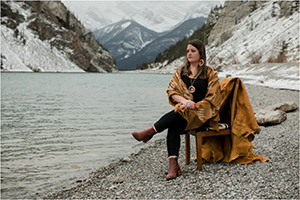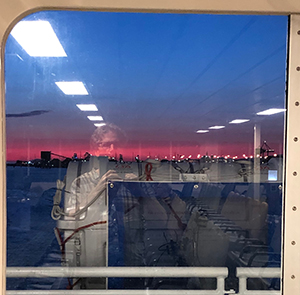Beading Tethered to Writing:
Iain Higgins interviews
Jaymie Campbell

Editor Iain Higgins talks with Jaymie Campbell, whose essay "Beads Are the Best Conversationalists" appears in our summer issue #223. They discuss Jaymie’s relationship to the materials she uses, writing as a way to process beading work, and the perfect pieces that emerge from moments of imperfection.
Jaymie Campbell is an Anishnaabe artist and writer from Curve Lake First Nation and currently resides on unceded Sinixt territory in BC. She explores connection through visual arts and writing, and is inspired by story, the land and family.
I very much enjoyed reading “Beads Are the Best Conversationalists” (a wonderful title!), which not only gives readers like me (of settler-colonial descent) a sense of how your beautiful beadwork comes into being, but also generously allows us to listen in on the conversations you are having with yourself, your materials, your experiences, your inheritances, and so on, while you are beading. You begin your account by setting yourself in a very clearly described time and place (late night, quiet, at home, with your dog as well as a little sustenance, a spotlight, and your materials). Why do you want readers to know where and when as well as how do you your work?
It was important to me to tell the story in this way because it really draws a connection between being an artist and being a writer. A lot of what people see from the outside are the finished pieces or projects, and they don’t necessarily get a lot of insight into the process of that creation. More often than not it comes with struggles, self-sacrifice, loneliness. But it is also in that dark quiet that some of my best self-growth, healing and connection has occurred. It is the small perfect pieces that emerge from these moments of absolute imperfection. This has been true for me both in art and writing. I really wanted to share the intimacy of that moment with readers and allow them to envision their own.
One of the many things that comes through in your account is your deep respect for the materials—the hide, the thread, the beads—that you are conversing with. Such respect is hardly ever found in the larger capitalist economy in which we almost all inescapably find ourselves nowadays, no matter where we are. What is it that makes these materials so important to you and do you feel the same way about the different materials—the words, the sentences—out of which your writing is made?
I love this question. I think as an artist a lot of what had developed my practice is interrogating my relationship with the materials I use. So much of it has been a journey in reclamation for me. When I tanned my first hide, it had been over 60 years since anyone in my immediate family had done so. I wanted to let go of expectations and really allow myself to be immersed in my relationship with that animal and all the things that process was teaching me. It is the same for other materials as well. If you slow down and pay attention, there are always deeper teachings from the animals, the materials and my ancestors. For the writing piece, I think the words I use are born from trying to find a way to speak about that relationship in a way that conveys the deep respect and reciprocity I feel, but I often struggle with landing them exactly. I think if I could speak my language that I lost, the words would come easier, more clearly. So it is often also an exercise in feeling like it isn’t entirely right, but the best I can do.
In bringing together beading and writing as you do in your account, you very nicely connect the work you do with your hands with the work you do with your head and, especially, your heart. Do you see your beading and writing as related, complementary ways of becoming “tethered” (a beautiful word!) in the world, or are they separate activities with different aims?
They are absolutely tethered. I found so much of the outside pressure of being an artist came from the larger capitalist economies we live in. Writing about my work became a way for me to process and connect to the work I was doing with my hands and ground it again when the pressure becomes too much. Reminding myself about how precious our materials and our teachings are, where we come from and our deep respect of the land. Writing for me started as a way to try and communicate the importance of that to people who may be unfamiliar with our art forms or see them as simply crafts or trinkets.
In your essay, your sense of the beads as reflective of the faces they will encounter is very moving, especially when you think of the various places where your beadwork might be worn: courtroom, stage, delivery room, grocery store. Is it important to you to think of your beads as worn—maybe as medicine, as you say—in places that include institutional or commercial sites that too often remain hostile to Indigenous people in the settler-colonial nation-state of Canada? In addition to being medicine, what else do you imagine the beads doing in those places?
It is a cornerstone of being an Indigenous artist for me to think about the places that beadwork will end up. I used to do governance and consultation work for a nation in Alberta, and I often found myself in institutional and corporate rooms that felt unsafe. It was one of the things that inspired me to start creating beadwork that could be protective in those spaces – that could share the scent of home-tanned hide or allow the wearer to touch them to ground themselves. I like to imagine as that beadwork sways on our ears or around our necks it reminds us of where we come from and keeps us protected by ancestral energy.
The sense of conversation—to return to the opening of our interview here—that emerges in “Beads Are the Best Conversationalists” is as rich as the word itself, whose web of meanings includes not just talking with others and ourselves, but also dwelling with them, moving with them. In other words, conversations involve us in relationships, reciprocity, responsibilities. What sort of conversations (with their attendant relationships, reciprocity, and responsibilities) would you like your beads and your writings to give rise to when they go out into the daylight world after being made in your nighttime workshop?
For me, this piece was a deep exploration of my spiritual connection to beadwork and about my ancestors. A nod, if you will, to the generational connection to beads and working with my hands that resonates deeply when I am in that space. It is an exploration of a different continuum of time, where the beads represent not only the possibilities and iterations of myself, but also all of those things for my ancestors, both past and present. I suppose that I have dual hope—I hope that the beads and the writings lead to important conversations about art, about being multi-faceted beings, about culture and ultimately about complicated issues like reconciliation and truth. In the same way, I hope they don’t lead to further labour for my kin. It’s a complicated space, but I always hope the daylight brings new perspectives.

Iain Higgins
* * * * * * * *









